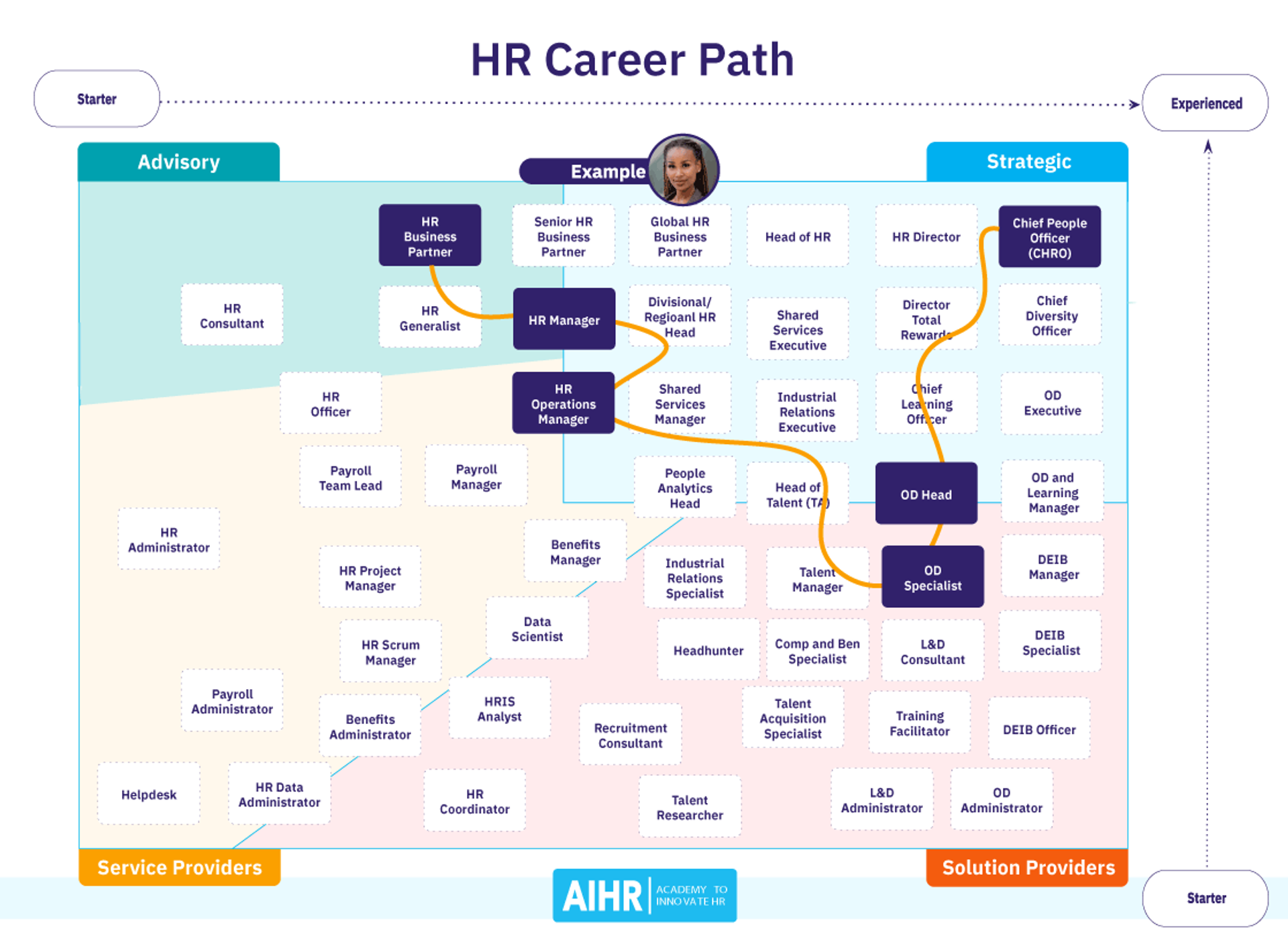Career path
What is career path?
What is a career path?
The concept of a career path can be viewed from two perspectives: organizational (structural) or individual (personal), as a series of decisions, actions, and steps taken by an employee to achieve professional goals. This article focuses on the organizational perspective.
A career path is the sequence of positions an employee can hold within a company. Each stage involves new challenges, a broader scope of responsibility, and opportunities to gain valuable experience. Once specific criteria are met and required competencies are acquired, employees can advance to higher positions or take on new roles in other departments or areas, thus continuing their professional growth. Career paths are a key element of talent management strategies.
Types of career paths in organizations
Career paths can take a vertical structure, involving upward advancement (the so-called career ladder), or a horizontal structure, where employees develop in various areas or specializations (lateral advancement). Increasingly, organizations are adopting flexible career path models, adapting them to both employee needs and changing market demands. In these models, competencies play a primary role, rather than formal education.
What are the components of a career path?
A career path should include the following elements:
- Goal – A clearly defined alignment between individual career objectives and organizational strategic priorities, ensuring that the development of employee skills and competencies directly contributes to business growth and long-term success.
- Organizational structure – A precisely defined job hierarchy and possible advancement paths (e.g., vertical, horizontal, diagonal, as well as specialist or managerial tracks) that directly contribute to leadership development and succession planning, ensuring a robust pipeline of talent for key organizational roles.
- Job descriptions – Including the required qualifications, experience, and key competencies required at each stage of career development.
- Competencies and skills – A catalog of hard and soft skills required at various stages of professional development, along with an analysis of competency gaps.
- Development and training programs – Covering both internal and external training, mentoring programs, coaching, e-learning, and professional courses tailored to employee needs, with a focus on measurable ROI, such as improved productivity, enhanced employee retention, and long-term organizational growth.
- Evaluation and feedback system – A system of regular performance reviews and feedback sessions that drive performance optimization, align individual efforts with organizational KPIs, and support employee development in achieving their goals.
- Succession plan – A strategy for preparing employees to take on key roles within the organization, ensuring continuity and operational stability.
- Attractive benefits and incentives – Including competitive compensation, bonuses, rewards, and non-financial support such as flexible working hours, all of which play a critical role in talent acquisition, retention strategies, and enhancing overall workforce satisfaction metrics.
Career pathways – business benefits
Organizations that offer clear, well-defined career development pathways not only strengthen their employer brand as attractive places to work but also achieve tangible business advantages:
- Reduced turnover and lower talent acquisition costs. Defined career paths provide employees with a sense of direction and purpose, leading to higher retention rates and significantly reducing recruitment and onboarding expenses.
- Increased motivation and team engagement. Employees who see a future within the organization are more likely to invest in developing their skills and embracing ambitious challenges. When their efforts are recognized and rewarded, productivity, engagement, and job satisfaction all increase.
- Fostering a culture of innovation. Clearly structured career pathways, paired with professional development programs, create a culture of continuous learning that drives motivation and innovation across the organization.
- Improved operational efficiency. Investments in both technical and soft skills development enhance team competencies, directly boosting overall performance and efficiency.
- Developing future leaders. Career pathways help identify and nurture top talent for leadership roles, ensuring organizational stability and long-term continuity.
- Knowledge transfer as a competitive advantage. As employees grow, their expertise and specialized knowledge become valuable assets that can be leveraged organization-wide, increasing flexibility and driving growth potential.
- Attracting top talent. A strategic focus on career development is a powerful recruitment tool, appealing to talent across all career stages, from returning workforce members to seasoned professionals seeking fresh challenges.
Career pathways – challenges and solutions
Below are the most common challenges in developing team potential through career pathways and actionable solutions to overcome them:
Varied levels of motivation. Employees across different generations have diverse motivators, and not everyone prioritizes personal development.
✅ Solution: Conduct regular surveys to understand employee needs and preferences, tailoring development programs to meet their expectations.
Lack of support. Not all managers possess the skills and experience needed to effectively support employees’ career development.
✅ Solution: Invest in leadership training to enhance coaching capabilities and talent management skills.
Different learning styles and needs. Employees learn in varied ways, and a one-size-fits-all training approach can limit knowledge retention and effectiveness.
✅ Solution: Offer diverse learning formats, such as online courses, workshops, and mentoring, to accommodate different learning preferences.
Limited advancement opportunities. In smaller organizations, upward mobility can be restricted, making it challenging to design long-term career pathways.
✅ Solution: Focus on horizontal skill development and create opportunities for expanded responsibilities within existing roles.
Inconsistent implementation across departments. If development programs are applied unevenly, employees in excluded departments may feel disengaged or demotivated.
✅ Solution: Adopt a centralized approach to designing and implementing career pathways, ensuring consistency across the organization.
Resistance to change. Some employees may resist learning new skills, particularly if they feel inadequately compensated for their current responsibilities.
✅ Solution: Emphasize the benefits of development and implement transparent reward systems to recognize achievements and progress.
Inconsistent progress tracking. Without systematic evaluation, it becomes difficult to measure the impact of development efforts on business goals.
✅ Solution: Introduce regular performance assessments and leverage modern analytics tools to track progress effectively.
How HR can implement effective career pathways in the organization
Career pathways are a key component of talent management strategy, driving employee motivation and organizational success. If your company hasn’t yet defined clear development paths, it’s time to act!
Step 1: Understand organizational and employee needs
- Define business objectives and the core competencies required to achieve them.
- Identify employee aspirations through surveys, 1:1 meetings, or feedback sessions to align expectations.
- Pinpoint skills gaps to effectively plan development initiatives.
Step 2: Create clear job and competency profiles
- Develop competency profiles for each role, specifying what employees need to achieve in order to advance.
- Build a job framework that outlines vertical and horizontal career progression opportunities.
- Establish promotion criteria, including experience, performance, and acquired skills.
Step 3: Design comprehensive career pathways
- Plan multiple pathway options, including:
- vertical advancements – moving to higher roles;
- horizontal advancements – transitioning into specialist roles;
- parallel pathways – cross-functional development in other departments or projects;
- hybrid pathways – combining diverse competencies.
💡 Example: In HR, a linear career path could look like: Intern → Junior HR Specialist → Senior HR Specialist → HR Manager. For inspiration, the career map below, developed by AIRH, illustrates the full range of growth opportunities within a single department.

Step 4: Launch development programs
- Plan supplementary training and courses (internal and external) for each career pathway.
- Introduce mentoring, coaching, or job rotation programs to help employees gain new skills through diverse experiences.
- For high-potential employees, design dedicated development plans.
Step 5: Focus on communication and transparency
- Create informational materials for candidates and employees, such as career maps outlining pathways and promotion criteria.
- Involve managers in the process and encourage them to discuss career growth during performance reviews.
Step 6: Monitor progress and evaluate effectiveness
- Conduct regular career development reviews, such as during annual performance evaluations.
- Periodically assess the impact of career pathways and implement data-driven adjustments as needed.
- Leverage HR tools, such as platforms like PeopleForce, to track progress and analyze data effectively.
Step 7: Inspire employee growth and empower leaders to drive development
- Implement reward systems that recognize achievements and skill development, along with recognition programs that promote growth and engagement.
- Provide managers with training to develop their soft skills and leadership abilities, enabling them to better support employee growth.
Career pathways: summary
Career pathways are a strategic tool that set the direction for organizational growth, strengthen retention of top talent, and attract the best candidates, creating a competitive edge. Utilize the analytical capabilities of HR platform to align pathways with business goals and effectively develop employee potential.

